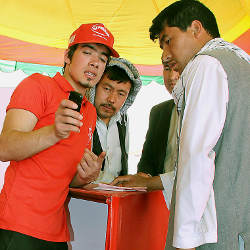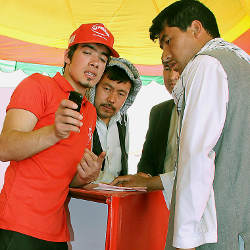
One-quarter of humanity lives in fragile, violent, and conflict-stressed environments. These people’s lives are often characterized by the starkest of realities: undernourishment, illiteracy, short life spans, even lack of access to basic sanitation and clean water. Destroyed and diminished infrastructure, weak institutions, and endemic mistrust and suspicion characterize conflict-affected countries. Moreover, these harsh conditions can have global effects as conflict-stressed environments export extremism, regionalize discord, and create worldwide instabilities.
Peacebuilding is the collective processes to end or mitigate conflict, rebuild and reconcile post-conflict, and foster conditions that avoid conflict in the first place. So what is the role and promise of computer and communication technologies in peacebuilding efforts?
Traditional media, such as radio and print journalism, is well established as an essential element in peacebuilding programs. But as access to mobile phones and social media expands—strikingly even in these same conflict-stressed environments—attention is increasingly turning to the transformational promise of such technologies to enhance or replace old media in peacebuilding.
As Shanti Kalathil5 and her co-authors have noted, the traditional media formulation of communication technologies and peacebuilding “viewed the receivers of information and ideas sitting passively on the receiving end of a carefully crafted donor message.” But today’s mobile and social media technologies demonstrate how interactive “dialogue is just as important, if not more important” in peacebuilding efforts. As one popular formula puts it—as long as you are talking, you can’t be shooting.
Mobile Phones
Mobile phones are becoming fundamental technologies in enabling this peacebuilding dialogue. Indeed, mobile phones seem not to only persist in conflict-stressed environments but to flourish. Even the world’s most conflict-affected countries have robust mobile phone networks. Somalia, often topping the global list of failed states, has five mobile phone operators. Daniel Stauffacher7 and colleagues have noted how in Somalia “state failure and the accompanying lack of regulatory systems has enabled the creation of one of Africa’s most extensive and resilient cellular telephone systems, accompanied by numerous satellite-based Internet access points” (emphasis added). In some perverse sense, conflict-induced state failure may have actually facilitated mobile phone penetration.
Indeed, through statistical comparison of a country’s cellular penetration against measures of economic, social, and political strength I have found mobile phone penetration seems rather immune to conflict and insecurity.1 I recently examined data from the Brookings Institute’s Index of State Weakness in the Developing World from 2008 and compared it with 2008 ITU mobile phone penetration figures. The Brookings index ranks states on their economic, political, social, and security strengths. Not surprisingly, a state’s economic strength positively correlates with its mobile phone penetration—richer countries have more phones per capita. Similarly strong positive relationships exist between mobile phone penetration and the Brookings Institute’s indicators for political and social strength. Indeed, all these variables are strongly and positively related to mobile phone penetration. And so it is all the more incredible that the security indicator—which includes factors related to conflict intensities, political stability, coups, gross human rights abuses, and territory affected by conflict—does not explain variation in mobile phone penetration levels; these two variables’ relationship is weak and statistically insignificant.
Put simply, mobile phone penetration is sensitive to money, politics, and social development—but seems immune to insecurity and conflict.
What might drive flourishing user adoption of mobile phones in conflict-stressed settings? The West African nation of Liberia is one of the world’s poorest and most conflict-affected countries, having emerged in 2003 from more than 15 years of civil war. With otherwise weak infrastructure, Liberia’s mobile phone sector has been thriving. But why?
Researchers at Georgia Tech surveyed 85 mobile phone users in both the capital city and rural areas, and interviewed industry experts to identify why so many Liberians were using mobile phones.2 Directly linked to Liberia’s post-conflict high-threat environment, the most common motivation for mobile phone adoption across our informants was the way the phone enhanced their personal security. In a country with deep fissures, high levels of unemployment, and concomitant criminality it is understandable that a mobile phone is seen as providing personal security; a centerpiece requirement to post-conflict peacebuilding. For instance, one phone company manager mentioned that when his company considered removing free calling during late night hours, customers complained. Late at night was when they most needed the ability to make calls without credit on their phone, in case of an emergency situation. Another operator suggested that many users leave their phones on at night for safety rather than switch them off to conserve battery charge.
What is the role and promise of computer and communication technologies in peacebuilding efforts?
Even Afghanistan—which suffers from the world’s lowest security index according to the aforementioned Brookings rankings—has a robust mobile phone sector with five operators and more than 13 million subscribers. In this deeply conflict-scarred country, mobile phone applications that move beyond simple voice and text communication are emerging with important peacebuilding implications. M-Paisa (“paisa” means “money” in the local language, Dari) is a mobile banking service that allows users to deposit, withdraw, and transfer money as well as pay for goods and bills with participating vendors. In low-security high-threat areas such as Afghanistan, traveling with large amounts of cash on hand is both particularly common and particularly dangerous. The M-Paisa service responds to this significant problem by reducing the amount of cash individuals must keep on their person.
Furthermore, according to a report from the United States Institute of Peace,4 M-Paisa has also been useful in mitigating corruption endemic to conflict and post-conflict zones: “Perhaps most significant in terms of the conflict has been the use of M-Paisa to distribute salaries to members of the Afghan National Police. Fifty officers in [the pilot program] received 30% larger payments with the program… because salary poaching from their commanding officers and manual transport methods were reduced.”
Print illiteracy is pervasive in many conflict-stressed environments and nowhere is this truer than in Afghanistan. Therefore, one of the important technical enhancements of the M-Paisa service was the development of an interactive voice response (IVR) system supporting Dari, Pashto, and English. M-Paisa is responding to some of the core realities of this conflict-stressed environment: high levels of insecurity and low levels of literacy.
Social Media
Whether accessed on mobile phones, through cybercafés or other means, social media platforms, and methods to monitor them, are also emerging as important technologies for peacebuilding. One critical component in building and sustaining peace are political developments and democratic reforms that set the stage for broader participatory governance. Social media can support these developments up to and including elections. For example, the social media mapping platform Ushahidi has been used to facilitate crowdsourced monitoring and response in multiple elections across the globe. In fact, this technology was created in early 2008 as a response to failed elections in Kenya.
Research at Georgia Tech is taking the possibilities of peacebuilding through social media a step further. Our software system, built specifically for election and conflict monitoring, can aggregate and analyze multiple social media streams including Twitter, Facebook, Ushahidi instances, blogs, and more. The software, called Aggie, handles large volumes of data performing in real-time keyword extraction and text analysis, incidence identification, and topic visualization.
In April 2011, Nigeria became a perfect test environment for this technology when the West African nation conducted elections for national and state offices. Previous contests in 2003 and 2007 were marked by accusations of electoral fraud and violent protests across the country. Whether or not the 2011 election would bring similar upheaval was an open question. Working with collaborators at Harvard and with a consortium of youth activists in Nigeria called Enough is Enough, we linked our social media monitoring technology to a response situation room based in Nigeria’s capital, Abuja. Our software in real time tagged and flagged social media reports of ballot and election irregularities, sending them both as timeline visualizations and triagable event lists to the Abuja situation room. If, for example, our software identified a report of a polling place running out of ballot papers, that report would be sent to the Abuja team who could call the election commission and inform them of the concern.
Social media platforms, and methods to monitor them, are emerging as important technologies for peacebuilding.
Tragically, as the initial presidential returns started to come in, rioting broke out in northern Nigeria after an opposition candidate for President claimed election fraud. Thousands of people were being injured and killed. In response, we quickly reconfigured our software tool to also flag reports of violence, which the Abuja situation room would then triage and if indicated call upon the police or military for action. At the height of the unrest we were receiving 50 reports a second, analyzing them in real time, and forwarding tagged visualizations to Abuja.
Routinely, our social media monitoring technology was out front of both national security forces and traditional media in identifying and initiating responses to electoral irregularities and conflict. Ultimately we believe that by using our software system to connect reports expressed through social media directly to real-time response we were able to attenuate elements of election-related violence and help return the country to peace. Our system was engineered to specifically respond to the peace-sustaining and conflict-response needs of the Nigerian election by monitoring, for instance, not just general-purpose social media streams such as Twitter but also crises-response platforms such as Ushahidi.
Technologies for Peacebuilding
The promises of computer and communication technologies for peacebuilding are palpable. For example, in a systematic study of users of interactive rich media technologies and post-conflict reconciliation in Liberia, we have discovered how these computer systems can have deep psychological effects important to peacebuilding and national healing.3 These early results notwithstanding, considerable research is required to fully understand the effect of these systems in helping bring and sustain peace in troubled nations.
M-Paisa in Afghanistan and our social media tracking system in Nigeria demonstrate some of the ways that information and communication technologies can be purpose-built to respond to the realities of conflict-stressed environments and the particularities of peacebuilding. Search for Common Ground6 has identified a number of the realities that need to inform ongoing research and development in peacebuilding technologies: collaboration and management of information flows; trust and validation; environmental factors; privacy, security and ethical challenges.
A new engineering and research agenda needs to emerge to tackle these pressing issues and answer questions such as:
- How do we manage the privacy and security needs particular to conflict-stressed environments; when is anonymity required and when does it diminish trust?
- What are new forms of conflict-durable, rapidly deployable, and self-healing network infrastructures?
- How do we innovate new interface modes and methods for use by communities where a generation is unschooled and there is a pervasive low level of print and computer literacy?
- How do we analyze and validate large volumes of information collected from decentralized sources across social media platforms; how to account for the biases inherent in unequal access to these very systems?
- What new methods are needed to monitor and access the impacts of computer and computer technologies in peacebuilding?
While interest in these technologies is flourishing among scholars, policy makers, and international organizations,a there remain plenty of unanswered questions—and unmet possibilities—for information and communication technologies and peacebuilding.





Join the Discussion (0)
Become a Member or Sign In to Post a Comment